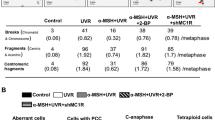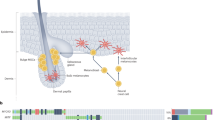Abstract
Pigmentation is a significant determinant of individual susceptibility to cutaneous melanoma, with fair skinned subjects at highest risk of developing this neoplasm. Melanocortin 1 receptor (MC1R) gene variants alter pigment synthesis in vivo, and are causally associated with red hair and fair skin in humans. MC1R variants are more frequent in subjects with melanoma, and increase the risk of developing this tumour in sporadic and familial cases. MC1R variants may predispose to melanoma as a result of alterations in skin pigmentation (which affords less protection against incident ultraviolet radiation). However, melanoma cells synthesize and release alpha-melanocyte stimulating hormone (αMSH, the ligand for MC1R), therefore MC1R variants could alter the autocrine effects of αMSH on melanoma cell behaviour, thereby affecting early melanoma development and progression via non-pigmentary mechanisms. B16G4F melanoma cells, which are functionally null at Mc1r, were stably transfected with wild type and variant (Arg151Cys, Arg160Trp, and Asp294His) human MC1R. At similar MC1 receptor numbers per cell, αMSH increased intracellular cAMP in wild type MC1R transfected melanoma cells, but the cAMP response was compromised in the variant MC1R transfected clones. In growth inhibition experiments, αMSH significantly reduced growth of wild type MC1R transfected cells, but had no effect on cells transfected with variant MC1R. In addition, binding to fibronectin was significantly reduced by αMSH in the wild type transfectants whereas this was not observed in the variant transfected clones; binding to laminin was not affected by αMSH in this cell line. These results provide evidence for differences in melanoma cell behaviour secondary to MC1R variants, and suggest an alternative non-pigmentary mechanism whereby MC1R variants could modify melanoma susceptibility or progression.
This is a preview of subscription content, access via your institution
Access options
Subscribe to this journal
Receive 50 print issues and online access
$259.00 per year
only $5.18 per issue
Buy this article
- Purchase on Springer Link
- Instant access to full article PDF
Prices may be subject to local taxes which are calculated during checkout





Similar content being viewed by others
References
Abdel-Malek ZA . 2001 Cell. Mol. Life Sci. 58: 434–441
Bastiaens MT, ter Huurne JA, Kielich C, Gruis NA, Westendorp RG, Vermeer BJ, Bavinck JN . 2001 Am. J. Hum. Genet. 68: 884–894
Box NF, Duffy DL, Chen W, Stark M, Martin NG, Sturm RA, Hayward NK . 2001b Am. J. Hum. Genet. 69: 765–773
Box NF, Duffy DL, Irving RE, Russell A, Chen W, Griffyths LR, Parsons PG, Green AC, Sturm RA . 2001a J. Invest. Dermatol. 116: 224–229
Box NF, Wyeth JR, O'Gorman LE, Martin NG, Sturm RA . 1997 Hum. Mol. Genet. 6: 1891–1897
Chluba-de Tapia J, Bagutti C, Wikberg JS, Chhajlani V, Eberle AN . 1995 J. Recept. Signal Transduct. Res. 15: 43–53
Chluba-de Tapia J, Bagutti C, Cotti R, Eberle AN . 1996 J. Cell Sci. 109: 2023–2030
Clark EA, Golub TR, Lander ES, Hynes RO . 2000 Nature 406: 532–535
Corbin JD, Francis SH . 1999 J. Biol. Chem. 274: 13729–13732
Crombie IK . 1979 Br. J. Cancer 40: 185–193
Flanagan N, Healy E, Ray A, Philips S, Todd C, Jackson IJ, Birch-Machin MA, Rees JL . 2000 Hum. Mol. Genet. 9: 2531–2537
Ghanem G, Verstegen J, Libert A, Arnould R, Lejeune F . 1989 Pigment Cell Res. 2: 519–523
Haake A, Holbrooke K . 1999 Fitzpatrick's Dermatology in General Medicine 5th edn Freedberg IM et al., (eds) New York: McGraw-Hill pp. 70–113
Harding RM, Healy E, Ray AJ, Ellis NS, Flanagan N, Todd C, Dixon C, Sajantila A, Jackson IJ, Birch-Machin MA, Rees JL . 2000 Am. J. Hum. Genet. 66: 1351–1361
Haycock JW, Wagner M, Morandini R, Ghanem G, Rennie IG, MacNeil S . 1999 J. Invest. Dermatol. 113: 560–566
Healy E, Flannagan N, Ray A, Todd C, Jackson IJ, Matthews JN, Birch-Machin MA, Rees JL . 2000 Lancet 355: 1072–1073
Healy E, Jordan SA, Budd PS, Suffolk R, Rees JL, Jackson IJ . 2001 Hum. Mol. Genet. 10: 2397–2402
Hedley SJ, Gawkrodger DJ, Weetman AP, Morandini R, Boeynaems JM, Ghanem G, MacNeil S . 1998 Br. J. Dermatol. 138: 536–543
Humphries MJ, Olden K, Yamada KM . 1986 Science 233: 467–470
Iwamoto Y, Robey FA, Graf J, Sasaki M, Kleinman HK, Yamada Y, Martin GR . 1987 Science 238: 1132–1134
Jiang J, Sharma SD, Nakamura S, Lai JY, Fink JL, Hruby VJ, Hadley ME . 1995 Pigment Cell Res. 8: 314–323
Jiminez-Cervantes C, Olivares C, González P, Morandini R, Ghanem G, García-Borrón JC . 2001 J. Invest. Dermatol. 117: 156–158
Kaidbey KH, Agin PP, Sayre RM, Kligman AM . 1979 J. Am. Acad. Dermatol. 1: 249–260
Karjalainen JM, Eskelinen MJ, Nordling S, Lipponen PK, Alhava EM, Kosma VM . 1998 Br. J. Cancer 77: 1917–1925
Kennedy C, ter Huurne J, Berkhout M, Gruis N, Bastiaens M, Bergman W, Willemze R, Bavinck JN . 2001 J. Invest. Dermatol. 117: 294–300
Kijas JM, Moller M, Plastow G, Andersson L . 2001 Genetics 158: 779–785
Klungland H, Vage DI, Gomez-Raya L, Adalsteinsson S, Lien S . 1995 Mamm. Genome. 6: 636–639
Legros F, Coel J, Doyen A, Hanson P, Van Tieghem N, Vercammen-Grandjean A, Fruhling J, Lejeune FJ . 1981 Cancer Res. 41: 1539–1544
Loir B, Sales F, Deraemaecker R, Morandini R, Garcia-Borron JC, Ghanem G . 1998 Eur. J. Cancer 34: 424–426
Luger TA, Brzoska T, Scholzen TE, Kalden D, Sunderkotter C, Armstrong C, Ansel J . 2000 Ann. N.Y. Acad. Sci. 917: 232–238
Lunec J, Pieron C, Sherbet GV, Thody AJ . 1990 Pathobiology 58: 193–197
Marklund L, Moller MJ, Sandberg K, Andersson L . 1996 Mamm. Genome. 7: 895–899
Morandini R, Boeynaems JM, Hedley SJ, MacNeil S, Ghanem G . 1998 J. Cell Physiol. 175: 276–282
Moretti S, Massobrio R, Brogelli L, Novelli M, Giannotti B, Bernengo MG . 1990 J. Invest. Dermatol. 95: 320–324
Mountjoy KG, Robbins LS, Mortrud MT, Cone RD . 1992 Science 257: 1248–1251
Murata J, Ayukawa K, Ogasawara M, Fujii H, Saiki I . 1997 Invasion Metastasis 17: 82–93
Nesbit M, Herlyn M . 1994 Invasion Metastasis 14: 131–146
Neumann AG, Nagaeva O, Mandrika I, Petrovska R, Muceniece R, Mincheva-Nilsson L, Wikberg JE . 2001 Clin. Exp. Immunol. 126: 441–446
Newton JM, Wilkie AL, He L, Jordan SA, Metallinos DL, Holmes NG, Jackson IJ, Barsh GS . 2000 Mamm. Genome. 11: 24–30
Palmer JS, Duffy DL, Box NF, Aitken JF, O'Gorman LE, Green AC, Hayward NK, Martin NG, Sturm RA . 2000 Am. J. Hum. Genet. 66: 176–186
Rampen FH, Fleuren BA, de Boo TM, Lemmens WA . 1988 Arch. Dermatol. 124: 885–888
Ramsay JA, From L, Iscoe NA, Kahn HJ . 1995 J. Invest. Dermatol. 105: 22–26
Robbins LS, Nadeau JH, Johnson KR, Kelly MA, Roselli-Rehfuss L, Baack E, Mountjoy KG, Cone RD . 1993 Cell 72: 827–834
Romero-Graillet C, Aberdam E, Biagoli N, Massabni W, Ortonne JP, Ballotti R . 1996 J. Biol. Chem. 271: 28052–28056
Sawyer TK, Sanfilippo PJ, Hruby VJ, Engel MH, Heward CB, Burnett JB, Hadley ME . 1980 Proc. Natl. Acad. Sci. USA 77: 5754–5758
Schioth HB, Phillips SR, Rudzish R, Birch-Machin MA, Wikberg JE, Rees JL . 1999 Biochem. Biophys. Res. Commun. 260: 488–491
Smalley K, Eisen T . 2000 FEBS Lett. 476: 198–202
Smith R, Healy E, Siddiqui S, Flanagan N, Steijlen PM, Rosdahl I, Jacques JP, Rogers S, Turner R, Jackson IJ, Birch-Machin MA, Rees JL . 1998 J. Invest. Dermatol. 111: 119–122
Solca FF, Chluba-de Tapia J, Iwata K, Eberle AN . 1993 FEBS Lett. 322: 177–180
Takeuchi S, Suzuki H, Yabuuchi M, Takahashi S . 1996 Biochim. Biophys. Acta 1308: 164–168
Terranova VP, Williams JE, Liotta LA, Martin GR . 1984 Science 226: 982–985
Thody AJ, Hunt G, Donatien PD, Todd C . 1993 Ann. N.Y. Acad. Sci. 680: 381–390
Vage DI, Klungland H, Lu D, Cone RD . 1999 Mamm. Genome. 10: 39–43
Vage DI, Lu D, Klungland H, Lien S, Adalsteinsson S, Cone RD . 1997 Nat. Genet. 15: 311–315
Valverde P, Healy E, Jackson I, Rees JL, Thody AJ . 1995 Nat. Genet. 11: 328–330
Valverde P, Healy E, Sikkink S, Haldane F, Thody AJ, Carothers A, Jackson IJ, Rees JL . 1996 Hum. Mol. Genet. 5: 1663–1666
van der Velden PA, Sandkuijl LA, Bergman W, Pavel S, van Mourik L, Frants RR, Gruis NA . 2001 Am. J. Hum. Genet. 69: 774–779
Weinstock MA, Colditz GA, Willett WC, Stampfer MJ, Rosner B, Speizer FE . 1991 Am. J. Epidemiol. 133: 240–245
Acknowledgements
We are grateful to A Eberle for providing the B16G4F cell line, to S Phillips and JL Rees for providing the original pCR3.1 plasmids with wild type and variant MC1R, and to P Friedmann and LM Holden-Dye for helpful advice. The work was supported by grants from the Medical Research Council, the Wessex Medical Trust (HOPE), and the British Medical Association. E Healy is a Medical Research Council Senior Clinical Fellow.
Author information
Authors and Affiliations
Corresponding author
Rights and permissions
About this article
Cite this article
Robinson, S., Healy, E. Human melanocortin 1 receptor (MC1R) gene variants alter melanoma cell growth and adhesion to extracellular matrix. Oncogene 21, 8037–8046 (2002). https://doi.org/10.1038/sj.onc.1205913
Received:
Revised:
Accepted:
Published:
Issue Date:
DOI: https://doi.org/10.1038/sj.onc.1205913
Keywords
This article is cited by
-
Germline Melanocortin-1-Receptor Genotype Is Associated with Severity of Cutaneous Phenotype in Congenital Melanocytic Nevi: A Role for MC1R in Human Fetal Development
Journal of Investigative Dermatology (2012)
-
Protection against UVR Involves MC1R-Mediated Non-Pigmentary and Pigmentary Mechanisms In Vivo
Journal of Investigative Dermatology (2010)
-
Neuropeptide α-MSH exerts pro-inflammatory effects on Neisseria meningitidis infection in vitro
Inflammation Research (2010)
-
Variations of the melanocortin-1 receptor and the glutathione-S transferase T1 and M1 genes in cutaneous malignant melanoma
Archives of Dermatological Research (2006)
-
Anti-inflammatory and anti-invasive effects of α-melanocyte-stimulating hormone in human melanoma cells
British Journal of Cancer (2003)



